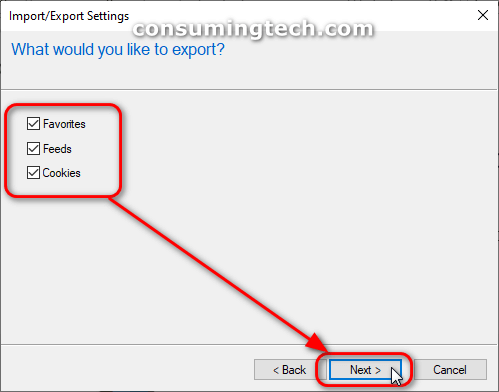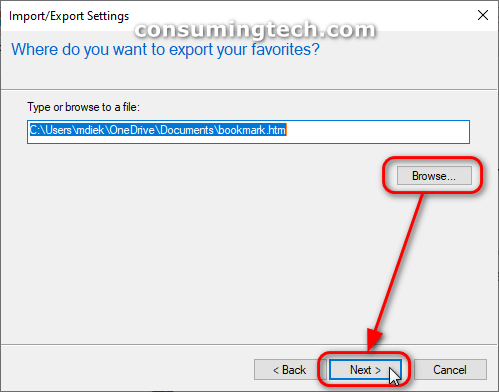Last Updated on December 25, 2022 by Mathew Diekhake
The following tutorial demonstrates how to import and export Internet Explorer Favorites, Feeds, and Cookies with HTM when using a version of the Windows 10 operating system.
Although Microsoft had developed a newer web browser, Internet Explorer was still available to use in Windows 10 when users made the upgrade; and in fact, IE 11 is still available to be opened today if you were to search for it from the search box in the taskbar.
IE being available is important for some people because many had gotten to know it over the years and still enjoyed using it. At some point those people will have to make the switch over to a newer browser such as Microsoft Edge however because the development of IE 11 has stopped, i.e., the IE browser has been discontinued. This will eventually lead to incompatibility problems as you always need to update a browser so that it works with the newer software that is attempting to be shown on it. There’s also the chance it will become a security risk as well.
But for the time being, there’s nothing wrong with using IE 11. Due to its popularity, it’s not uncommon for Windows users to open it up and check it out or use it as a second or third browser for some tasks they wish to be separated from their main daily browser. And there are some advantages to IE 11: websites tend to appear closer up when viewing from laptops than some alternatives, no toolbars are taking up unnecessary screen real estate, and it has tabs beneath the address bar which is unique to modern browsers for no particular reason.
Internet Explorer is no longer being developed, which means you will soon have no choice but to switch to another browser. Microsoft would like for that to be Edge, but you can also switch to Chrome or Firefox if you like. Additionally, some decent new names are worth trying as well, such as Vivaldi and Opera. Those who want to shun the advertising model may even want to give Brave a try. Though, we don’t recommend it as there are far too many publications relying on ads for them to all transition to subscription-based profits, and certainly not when the subscription mirrors the extortion experience publishers would be getting with Brave.
Once you have chosen a new browser to use, you may wish to import your data such as favorites, feeds, and cookies so you get the same experience you had built up over time with Internet Explorer. Before you can import, you must export the data. Both exporting from IE and importing to IE are done from the same area in Internet Explorer. If you are exporting from IE to another browser, you will need to look up how to import from that new browser to complete the task.
How to Import/Export Favorites from Internet Explorer to a .htm File
You can import and export browser data such as your favorites, feeds, and cookies from the Menu Bar in Internet Explorer 11. Here is how to do that:
1. Open Internet Explorer and then press the Alt key to show the Menu Bar in the browser.
2. With the Menu Bar visible, click on File and then click on Import/Export.
3. From the Import/Export Settings dialog, choose between Import from another browser, Import from a file, and Export a file, and then click on the OK button at the bottom of the box.
Note: If you want to save your data so it can be uploaded into another browser, choose the Export to a file checkbox.
4. From the Import/Export Settings dialog, check each checkbox (Favorites, Feeds, Cookies) that you want to import/export and then click on the Next button at the bottom of the box.
5. From the Import/Export Settings dialog, select the folder that you want to export your favorites from and then click on the Next button at the bottom of the box.
6. To Import/Export Favorites
a. From the Import/Export Settings dialog, select the location where you would like to export the favorites and then click on the Next button at the bottom of the box.
7. To Import/Export Feeds
a. From the Import/Export Settings dialog, select the location where you would like to export the feeds and then click on the Next button at the bottom of the box.
8. To Import/Export Cookies
a. From the Import/Export Settings dialog, select the location where you would like to export the cookies and then click on the Next button at the bottom of the box.
9. Click on the Finish button once you get the green ticks letting you know that each folder you wanted to be imported/exported has successfully been transferred.
In conclusion, that is how to import and export your favorites, feeds, and cookies. If you are exporting the data so it can be used on another browser, you will need to open the new browser of choice and choose to import. The files you chose to export are currently sitting on your computer and can be accessed through File Explorer — the exact path to the locations are listed during the Import/Export Settings dialog box in the tutorial above where it shows the option to browse and choose a new path.
(This article was last updated on September 28, 2021.)
Related Articles
- How to Reset Internet Explorer 11 Settings and Data to Default Condition in Windows 10 [Tutorial]
- How to Install/Uninstall Internet Explorer 11 [Tutorial]
- How to Add/Remove ‘Open Microsoft Edge Tab’ in Internet Explorer 11 [Tutorial]
- How to Hide/Show Search Box in Internet Explorer 11 [Tutorial]
- How to Turn On/Off Play Sounds in Webpages in Internet Explorer 11 [Tutorial]
- How to Add/Remove Internet Explorer 11 Power Options in Windows 10 [Tutorial]
- How to Open Internet Explorer in Windows 10 [Tutorial]
- How to Enable/Disable Enterprise Mode for Internet Explorer 11 [Tutorial]
- How to Open Website in Microsoft Edge with Internet Explorer [Tutorial]
- How to Turn On/Off Enterprise Mode for Websites in Internet Explorer 11 [Tutorial]
- How to Add/Remove ‘Open Microsoft Edge’ Tab in Internet Explorer 11 [Tutorial]
- How to Disable/Enable Internet Explorer in Windows 10 [Tutorial]








